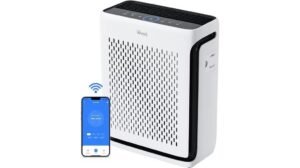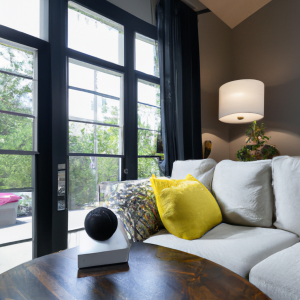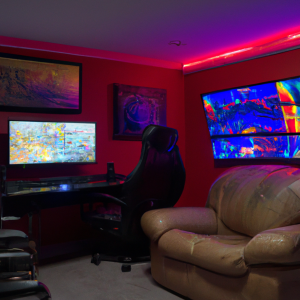As the famous adage goes, ‘the future is now.’
And nowhere is this more evident than in the world of smart home technology. With a wide range of devices and systems available, you can now control everything from your lights and thermostat to your security system and appliances with just a few taps on your smartphone or a simple voice command.
But what exactly is smart home technology, and how can it make your life easier?
In this article, we’ll explore the different types of smart home technology and their uses, from voice-activated assistants and smart thermostats to lighting systems and security devices. We’ll delve into the benefits of each, showing you how they can help you save money, time, and energy.
So whether you’re a tech enthusiast or just looking for ways to simplify your life, read on to discover how smart home technology can transform your everyday routines.
Key Takeaways
- Smart home technology offers convenience and ease of use with smartphone and voice control capabilities.
- Different types of smart home technology include smart thermostats, lighting systems, cameras, and security systems.
- The future of smart home technology includes seamless integration with wearables and the ability to track health and adjust the home environment accordingly.
- Risks associated with smart home technology include the possibility of hacking and data breaches, making it important for both manufacturers and users to prioritize security measures and educate themselves on protecting personal information.
Voice-Activated Assistants: A New Way to Control Your Home
You’re gonna love using voice-activated assistants to control your smart home – it’s like having your own personal AI assistant at your beck and call! With just a few simple commands, you can set the mood for your evening, adjust the temperature, and even order groceries.
The possibilities are endless with the integration of voice-activated assistants into your smart home.
One of the pros of using voice-activated assistants is the ease of use. You don’t need to fumble around with a remote or a smartphone app to control your smart home. Simply speak your commands, and your AI assistant will take care of the rest.
Additionally, voice-activated assistants are becoming more sophisticated, with the ability to recognize different voices and tailor responses accordingly.
However, there are also some cons to using voice-activated assistants. For example, they may not always understand your commands correctly, leading to frustration.
Additionally, there are concerns about privacy, as these devices are constantly listening to your conversations.
It’s important to weigh these pros and cons before deciding to integrate voice-activated assistants into your smart home. But if you do, the possibilities are endless.
Smart Thermostats: Saving Energy and Money
Using a smart thermostat can significantly reduce energy consumption and save money on utility bills. These devices allow you to control the temperature of your home remotely, so you can adjust it to your liking and ensure you’re not wasting energy when no one is home.
They also learn your schedule and preferences over time, automatically adjusting the temperature to your desired settings and maximizing energy efficiency. In addition to saving money, smart thermostats also offer convenience and comfort.
With the ability to control your thermostat from your phone, you can adjust the temperature without having to get up from the couch or bed. Some models even have voice control capabilities, allowing you to change the temperature without even lifting a finger.
Plus, with the added benefit of energy efficiency, you can feel good about reducing your carbon footprint while enjoying a comfortable home. Overall, smart thermostats are a great investment for anyone looking to save money on their utility bills and reduce their energy consumption.
With the ability to control your home’s temperature remotely and learn your preferences over time, these devices offer both convenience and comfort. So why not make the switch and start enjoying a more energy-efficient home today?
Lighting Systems: Customizable and Convenient
Imagine being able to control the lighting in your home with just a tap on your phone or a simple voice command. With the advent of smart home technology, this is now possible.
Lighting systems have become one of the most popular types of smart home technology, providing customizable ambiance and remote access capabilities. With customizable ambiance, you can create the perfect lighting setting for any occasion. Whether you want a cozy atmosphere for a romantic dinner or a bright, energizing workspace for a productive day, smart lighting systems can accommodate your preferences. You can even program your lights to automatically adjust throughout the day, mimicking the natural cycle of the sun to promote better sleep and wakefulness.
Remote access is another key feature of smart lighting systems. With just a few taps on your smartphone, you can turn your lights on or off, adjust their brightness, and even change their color. This level of control is especially convenient when you’re away from home and want to give the appearance that someone is still there.
With smart lighting systems, you can always be in control of your home’s lighting, no matter where you are.
Security Systems: Protecting What Matters Most
When it comes to protecting what matters most, having a security system in place can give you peace of mind and ensure the safety of your home and loved ones. Smart cameras are a great addition to any home security system.
These cameras can be placed strategically around the home to monitor any suspicious activity. They can also send alerts to your phone or other mobile device when motion is detected, allowing you to keep an eye on your home even when you’re away.
Remote monitoring is another feature of many smart home security systems. With remote monitoring, you can access your security cameras and other features from anywhere with an internet connection.
This means that you can check in on your home while you’re at work or on vacation. You can also arm and disarm your security system remotely, ensuring that your home is always protected.
Overall, smart home security systems are a great way to ensure the safety of your home and loved ones. With features like smart cameras and remote monitoring, you can have peace of mind knowing that your home is protected even when you’re not there. So why wait? Invest in a smart home security system today and rest easy knowing that you’ve taken steps to protect what matters most.
The Future of Smart Home Technology: What’s Next?
You may not realize it yet, but the future of smart home technology is already here. With the advancement of artificial intelligence, smart home devices are becoming more integrated and intuitive than ever before. And the integration doesn’t stop at just your home, as wearable devices are also being incorporated into the mix.
In fact, the next big thing in smart home technology is likely to be the seamless integration of all your devices. Imagine being able to control all your devices with just your voice, or having your home adjust to your preferences automatically. Smart home technology is already making this possible, but the future holds even more exciting possibilities.
For example, imagine being able to track your health through wearable devices and using that data to adjust your home’s environment to better suit your needs. But with all this integration comes concerns about privacy and security. As smart home technology becomes more advanced, the risk of hacking and data breaches becomes more prevalent.
It’s important for manufacturers to prioritize security measures and for users to educate themselves on how to protect their personal information. Overall, the future of smart home technology is bright and full of possibilities. As technology continues to evolve, we can expect even more seamless integration with wearable devices and a greater focus on enhancing our daily lives. The key is to embrace these advancements while also being mindful of potential risks.
Frequently Asked Questions
What are some of the potential drawbacks or risks associated with using smart home technology?
When using smart home technology, potential drawbacks include privacy concerns. Connected devices can gather personal data, which may be accessible to hackers or companies. Stay informed about security measures and use them to protect your privacy.
How do different types of smart home technology integrate with one another? Is it easy to set up and manage multiple systems?
Integrating different smart home technologies can be challenging, but with the right management solutions, it becomes easy. You’ll feel like a tech wizard once you’ve set up multiple systems and made them work together seamlessly, it’s a game-changer.
Are there any privacy concerns associated with using voice-activated assistants or other devices that collect personal data?
When using voice-activated assistants or devices that collect personal data, privacy concerns and data security should be taken seriously. It’s important to research the company’s privacy policies and consider using additional security measures, like two-factor authentication, to protect your personal information.
Can smart home technology be used to assist people with disabilities or mobility issues?
As the adage goes, necessity is the mother of invention. Assistive technology is no exception. Smart home technology can provide accessibility solutions for people with disabilities or mobility issues, making daily tasks easier and more manageable.
How do smart home systems compare in terms of cost and affordability? Are there any government incentives or programs available to help offset the cost of installation?
Looking to make your home smarter? Smart home cost effectiveness is important, and financing options are available. Check with your local government for incentives and programs to help offset the cost of installation.
Conclusion
So there you have it, the future is now and smart home technology is here to stay. With voice-activated assistants, smart thermostats, lighting systems, and security systems, our homes are becoming more efficient, convenient, and safe.
But what’s next for smart home technology? The possibilities are endless.
Imagine this: You’re sitting at work, miles away from home, but you’re able to check in on your elderly parents through your smart home security system. You notice that they haven’t moved in a while, and you become worried. You call them, but there’s no answer. You quickly call your neighbor and ask them to check on your parents. They find that your parents had fallen and were unable to get up.
Thanks to your smart home technology, you were able to save their lives.
This is just one example of how smart home technology can make a real difference in our lives. It’s not just about convenience and efficiency, it’s about safety and peace of mind.
So, embrace the future and let smart home technology improve your everyday life.


